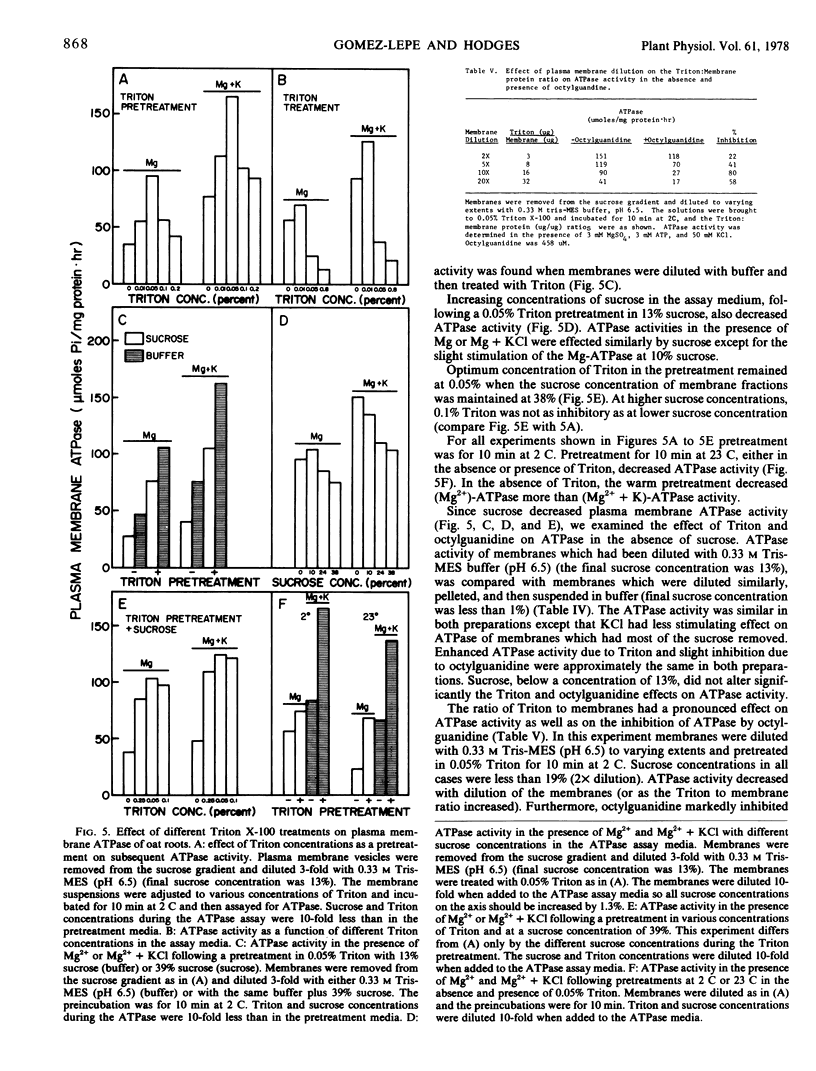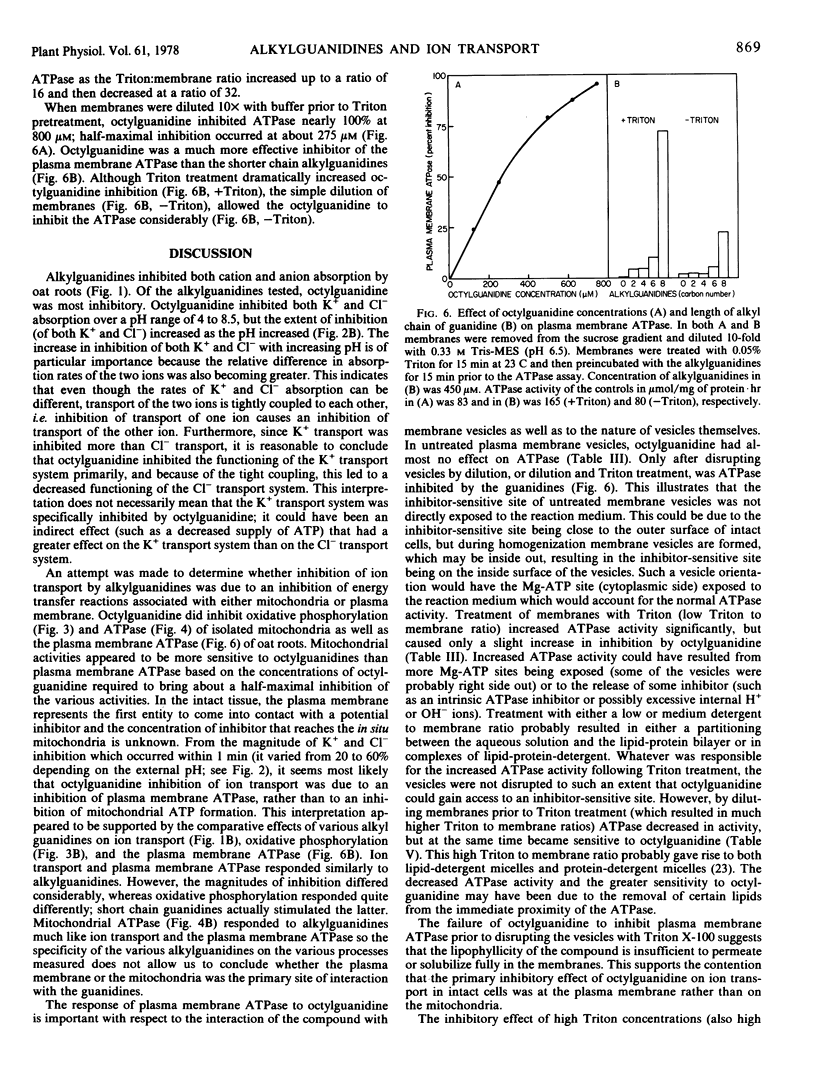Abstract
The effect of various alkylguanidines on ion absorption and energy metabolism in oat (Avena sativa cv. Goodfield) roots has been investigated. Of several alkylguanidines tested, octylguanidine was the most effective inhibitor of both K+ and Cl− absorption by excised roots. At 225 μm octylguanidine, the transport of both ions was inhibited within 60 seconds and to a similar extent. Octylguanidine inhibited mitochondrial oxidative phosphorylation and mitochondrial adenosine 5′-triphosphatase (ATPase). The plasma membrane ATPase was also inhibited if the membranes were diluted and pretreated with Triton X-100.
Concentrations of octylguanidine giving half-maximal inhibition of K+ influx, mitochondrial ATPase, oxidative phosphorylation, and plasma membrane ATPase were 50, 50, 100, and 275 μm, respectively. With increasing chain length, alkylguanidines (225 μm) became progressively more inhibitory to K+ absorption and to the mitochondrial ATPase. Shorter chain guanidines slightly inhibited the plasma membrane ATPase, however, these compounds produced a slight stimulation in oxidative phosphorylation.
Conditions of Triton treatment that were important in the elimination of permeability barriers of plasma membrane vesicles to ATP, Mg2+, KCl, and octylguanidine were: concentration of Triton during pretreatment and in the assay media, concentrations of sucrose and plasma membrane during Triton treatment, and temperature of Triton treatment.
Inhibition by octylguanidine of K+ and Cl− absorption by excised oat roots may be due to an inhibition of either the plasma membrane ATPase or mitochondrial oxidative phosphorylation. The isolated plasma membrane did not appear to be permeable to octylguanidine since the plasma membrane ATPase was inhibited only after treating the membrane with Triton. This result indicates that the primary site of action of octylguanidine in excised root is more likely to be the plasma membrane ATPase than mitochondrial oxidative phosphorylation.
Full text
PDF





Selected References
These references are in PubMed. This may not be the complete list of references from this article.
- CHANCE B., HOLLUNGER G. Inhibition of electron and energy transfer in mitochondria. II. The site and the mechanism of guanidine action. J Biol Chem. 1963 Jan;238:432–438. [PubMed] [Google Scholar]
- CHAPPELL J. B. The effect of alkylguanidines on mitochondrial metabolism. J Biol Chem. 1963 Jan;238:410–417. [PubMed] [Google Scholar]
- Davidoff F. Effects of guanidine derivatives on mitochondrial function. 3. The mechanism of phenethylbiguanide accumulation and its relationship to in vitro respiratory inhibition. J Biol Chem. 1971 Jun 25;246(12):4017–4027. [PubMed] [Google Scholar]
- Davidoff F. Guanidine derivatives in medicine. N Engl J Med. 1973 Jul 19;289(3):141–146. doi: 10.1056/NEJM197307192890308. [DOI] [PubMed] [Google Scholar]
- Dulley J. R. Determination of inorganic phosphate in the presence of detergents or protein. Anal Biochem. 1975 Jul;67(1):91–96. doi: 10.1016/0003-2697(75)90275-4. [DOI] [PubMed] [Google Scholar]
- Gómez-Puyou A., Sandoval F., Lotina B., Tuena de Gómez-Puyou M. Guanidine sensitive transport of Na + and K + in mitochondria. Biochem Biophys Res Commun. 1973 May 1;52(1):74–78. doi: 10.1016/0006-291x(73)90955-8. [DOI] [PubMed] [Google Scholar]
- Hille B. The permeability of the sodium channel to organic cations in myelinated nerve. J Gen Physiol. 1971 Dec;58(6):599–619. doi: 10.1085/jgp.58.6.599. [DOI] [PMC free article] [PubMed] [Google Scholar]
- Hodges T. K., Leonard R. T. Purification of a plasma membrane-bound adenosine triphosphatase from plant roots. Methods Enzymol. 1974;32:392–406. doi: 10.1016/0076-6879(74)32039-3. [DOI] [PubMed] [Google Scholar]
- LOWRY O. H., ROSEBROUGH N. J., FARR A. L., RANDALL R. J. Protein measurement with the Folin phenol reagent. J Biol Chem. 1951 Nov;193(1):265–275. [PubMed] [Google Scholar]
- Lepe B. G., Avila E. J. Alkylguanidines as inhibitors of k transport in isolated barley roots. Plant Physiol. 1975 Oct;56(4):460–463. doi: 10.1104/pp.56.4.460. [DOI] [PMC free article] [PubMed] [Google Scholar]
- Lotina B., de Gómez-Puyou M. T., Gómez-Puyou A. Respiratory changes induced by guanidines and cations in submitochondrial particles. Arch Biochem Biophys. 1973 Nov;159(1):520–527. doi: 10.1016/0003-9861(73)90484-0. [DOI] [PubMed] [Google Scholar]
- Nielsen T. R., Overstreet R. A Study of the Role of the Hydrogen Ion in the Mechanism of Potassium Absorption by Excised Barley Roots. Plant Physiol. 1955 Jul;30(4):303–309. doi: 10.1104/pp.30.4.303. [DOI] [PMC free article] [PubMed] [Google Scholar]
- Peña A. Studies with guanidines on the mechanism of K+ transport in yeast. FEBS Lett. 1973 Aug 1;34(1):117–119. doi: 10.1016/0014-5793(73)80717-3. [DOI] [PubMed] [Google Scholar]
- Saha S., Good N. E. Products of the photophosphorylation reaction. J Biol Chem. 1970 Oct 10;245(19):5017–5021. [PubMed] [Google Scholar]
- Schäfer G. Interaction of biguanides with mitochondrial and synthetic membranes. The role of phospholipids as natural binding sites. Eur J Biochem. 1974 Jun 1;45(1):57–66. doi: 10.1111/j.1432-1033.1974.tb03529.x. [DOI] [PubMed] [Google Scholar]
- Schäfer G., Rieger E. Interaction of biguanides with mitochondrial and synthetic membranes. Effects on ion conductance of mitochondrial membranes and electrical properties of phospholipid bilayers. Eur J Biochem. 1974 Aug 1;46(3):613–623. doi: 10.1111/j.1432-1033.1974.tb03657.x. [DOI] [PubMed] [Google Scholar]
- Tanford C., Reynolds J. A. Characterization of membrane proteins in detergent solutions. Biochim Biophys Acta. 1976 Oct 26;457(2):133–170. doi: 10.1016/0304-4157(76)90009-5. [DOI] [PubMed] [Google Scholar]


